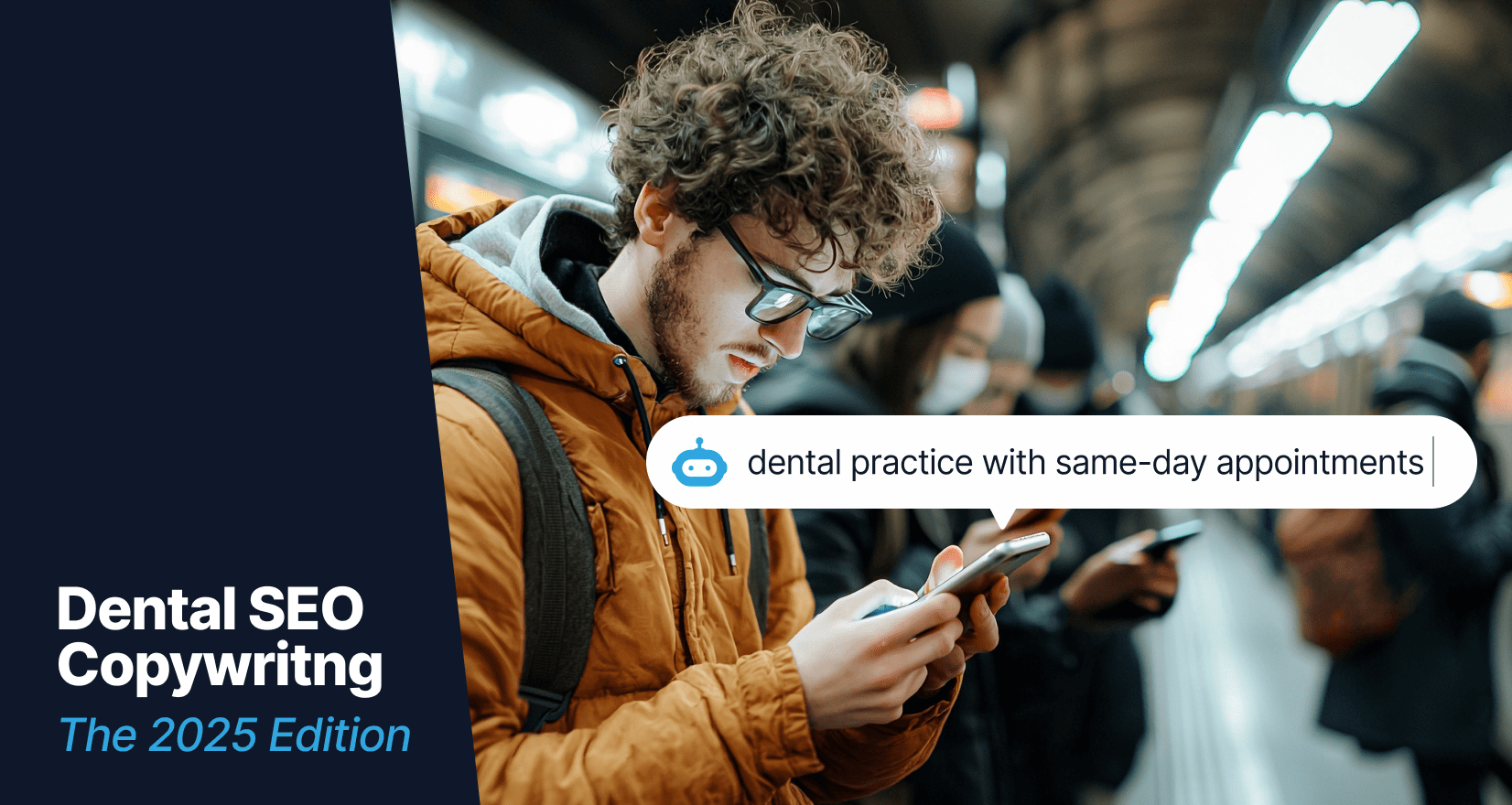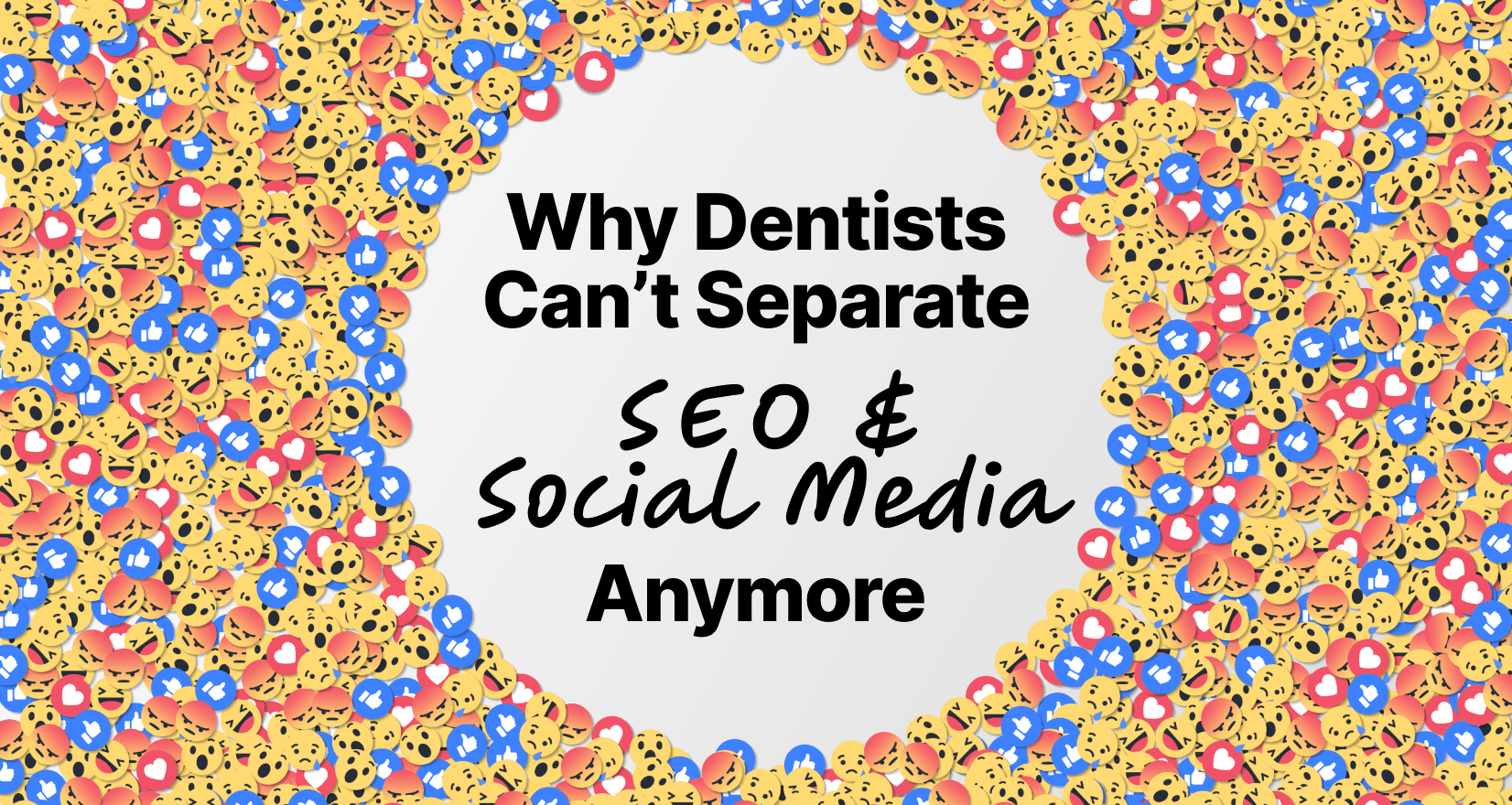
Dental SEO Copywriting in 2025 Is Smarter, Not Harder
Search engines have changed, and so have the rules of ranking. In 2025, dental SEO copywriting is no longer just about plugging in the right keywords or hoping Google notices your homepage. With AI-driven search results, voice assistants, and Google’s evolving algorithms, the way patients find dentists online looks very different than it did just a few years ago.
But here’s the good news: while search technology has advanced, the goal remains the same. Search engines want to show users the most helpful, relevant content. That means your dental website copy still plays a powerful role in how visible and trustworthy your dental practice appears online.
In this guide, we’ll break down how dental SEO copywriting works today, what has changed with AI search, and how you can write website content that attracts more patients, earns top rankings, and stands out in a crowded market.
Table of Contents
- What is Dental SEO Copywriting in 2025?
- How AI Search Is Changing the Dental Content Game
- Best Practices for SEO-Optimized Dental Copywriting
- High-Impact Areas for Custom Dental Website Copy
- Emerging Trends You Need to Know
- Common Mistakes to Avoid in Modern Dental SEO Copywriting
- SEO Is an Ongoing Relationship, Not a One-Time Fix
- FAQ
What is Dental SEO Copywriting in 2025?
Dental SEO copywriting is the art and science of writing website content that helps your dental practice rank higher in search engines while also building trust with potential patients. Success is not just about inserting keywords anymore. It’s about creating useful, well-structured content that answers real questions, highlights your expertise, and reflects the quality of care you deliver.
Search engines like Google are smarter than ever. With AI models powering search results, your content is being analyzed not just for keywords, but for depth, clarity, and relevance. Google’s algorithms now look at how well your content satisfies search intent, how it’s formatted, and whether it demonstrates authority in your field.
For dental practices, this means every word on your website—every service description, blog post, bio, and FAQ—plays a part in how you show up online. Great dental SEO copywriting is what turns curious searchers into confident patients.
How AI Search Is Changing the Dental Content Game
If you’ve noticed your web traffic behaving differently, you’re not imagining things. The rise of AI-powered search features—like Google’s Search Generative Experience (SGE), voice assistants, and instant answer boxes—has changed how patients interact with search results. Today, fewer users are clicking traditional blue links. Instead, they’re getting answers directly on the results page, often pulled from the content of high-performing websites.
This means your dental SEO copywriting has to work harder and smarter. Your content isn’t just competing for clicks, it’s competing to be the source of dental answers in AI-generated summaries.
Here’s what that means for your website:
- Content structure matters more than ever. AI favors clear, scannable copy with subheadings, bullet points, and direct answers to common questions.
- Relevance and context outweigh keyword repetition. AI search rewards content that demonstrates expertise, relevance, and helpfulness—not just keyword density.
- Zero-click searches are here to stay. If your copy provides a strong answer to a question, it can still drive visibility and dental brand recognition, even if users don’t immediately click through.
The bottom line? Google and AI tools are looking for content that is clear, helpful, and human-focused. When you write with patients in mind—anticipating their concerns, using conversational language, and organizing your content logically—you increase the chances of being featured in AI snippets and search summaries.
Best Practices for SEO-Optimized Dental Copywriting
If your goal is to show up on Google and connect with more local patients, your dental SEO copywriting needs to follow a smarter strategy than in previous years. The good news? You don’t need to be an algorithm expert. You just need to write with real people and search intent in mind.
Here are the top copywriting tactics that work right now:
Write for Search Intent, Not Just Keywords
Patients don’t search for “teeth whitening” because they want a technical breakdown. They want to know if it’s safe, affordable, and available near them. Your copy should speak to the why behind their search. Ask yourself:
- What question is this content answering?
- What is the next step a patient would want to take?
Every page on your site should clearly match the intent behind the search terms it targets.
Use Clear Structure and Formatting
AI and human readers both love organized content. Break your text into short paragraphs. Use headers (H2s, H3s) to signal important sections. Add bulleted lists, FAQs, and tables when possible. The easier your content is to skim and understand, the more likely it is to show up in featured snippets and AI-generated summaries.
Make It About the Patient
Google uses E-E-A-T signals to determine which sites are credible. Your dental content should highlight:
- Real experience (include the dentist’s background and credentials)
- Clear expertise (explain procedures simply and confidently)
- Authoritativeness (link to reputable sources or your own educational blog content)
- Trust (display reviews, photos, bios, and real patient results)
Prioritize E-E-A-T (Experience, Expertise, Authority, Trust)
Too many dental websites focus on what the practice offers, not what the patient needs. Instead of saying “We offer emergency dentistry,” write “If you have a toothache, our same-day emergency dental care can relieve your pain fast.” Speak directly to the patient’s concern and how you solve it.
Optimize Without Overdoing It
Use target keywords naturally. Place them in headers, your opening paragraph, and meta descriptions. But remember: don’t overuse them. Over-optimized content feels robotic and may hurt your rankings.
High-Impact Areas for Custom Dental Website Copy
Not all website content is created equal. Some pages carry more SEO weight than others, especially when it comes to ranking in local search results. To maximize the effectiveness of your dental SEO copywriting, focus on optimizing the pages that matter most to both patients and search engines.
Homepage: Your First Impression and Local SEO Powerhouse
Your homepage is prime digital real estate. It often ranks for your most competitive keywords like “dentist near me” or “family dentist in [city].” That means your homepage needs more than just a pretty design—it needs strategic, localized, patient-centered copy.
Make sure your homepage includes:
- A clear value proposition (“Gentle family dentistry with same-day appointments”)
- Your city and neighborhood name (to support local SEO)
- A short intro to your services
- Trust signals like Google reviews, insurance info, or awards
And yes, more copy is better. Don’t be afraid to include 300–500 words in strategic sections to help Google understand what your practice is all about.
Service Pages: One Page Per Procedure
Each dental service you offer deserves its own page. Why? Because patients don’t search for “dentist,” they search for “Invisalign for teens,” “root canal pain relief,” or “dental implants near me.” A dedicated service page allows you to match search intent with detailed, helpful information.
Make sure each service page includes:
- What the procedure is and who it’s for
- Answers to common questions
- Internal links to related services and blog content
- A clear call to action (CTA) to book a consultation
Pro tip: Pages with strong service-specific copy are also more likely to be featured in AI-generated search results.
About the Dentist Page: Build Trust and Boost Rankings
Your “Meet the Dentist” or “About Us” page is often the second-most visited page on a dental website. Patients want to know who they’re trusting with their health, and Google wants to know that your content is backed by real experience.
Enhance this page with:
- A professional bio written in a friendly, human tone
- Education, certifications, and continuing education
- Personal touches like hobbies, family, or community involvement
- A professional headshot or team photo
Not only does this help with E-E-A-T (Experience, Expertise, Authority, Trust), but it also boosts conversions by helping patients feel more connected to your practice.
Emerging Trends You Need to Know
Staying ahead in dental SEO means keeping up with the evolving ways patients search and interact online. AI and user behavior are driving major shifts in how content is discovered, ranked, and consumed. Here are the top trends every dental practice should be aware of when writing website copy.
AI-Powered Search Summaries
With tools like Google’s Search Generative Experience (SGE), AI is now summarizing search results directly on the page. These summaries pull from multiple websites to create an instant answer, often without the user clicking through.
What this means for you:
If your content is clearly written, well-structured, and matches the intent behind common questions, it has a better chance of being included in AI-generated responses. Think FAQ-style formatting, clean headings, and answers that get straight to the point.
Voice Search and Conversational Queries
More patients are using voice assistants like Siri, Google Assistant, and Alexa to find local healthcare. These queries are longer and more conversational—like “Who’s the best emergency dentist open now near me?”
How to adapt:
Write in a natural, question-and-answer format. Include long-tail keyword phrases that reflect how people actually speak. A blog post titled “How to Stop a Toothache at Home Before Your Appointment” is more likely to match voice search than something generic like “Toothache Tips.”
Topical Authority and Content Clusters
Google now rewards websites that cover a subject in depth. One-off blog posts or shallow pages won’t cut it anymore. Instead, build content clusters—a set of interlinked pages and blog posts around one core service or keyword.
Example:
If you want to rank for “dental implants,” create:
- A service page explaining the procedure
- Blog posts on recovery time, costs, success rates, and patient experiences
- Internal links between all these resources
Local SEO + Contextual Signals
Google’s local results are now heavily influenced by contextual content signals, not just business listings or reviews. Including your city, neighborhood, and even local landmarks in your copy helps you appear in local search and Maps results.
Tip:
Add geographic references naturally into your homepage, service pages, and blog posts. “We proudly serve families in Sandy, Draper, and South Jordan” is simple but powerful for local SEO.
Common Mistakes to Avoid in Modern Dental SEO Copywriting
Even with the best intentions, it’s easy to fall into outdated habits that hold your content back. If your goal is to improve rankings, attract local patients, and build trust online, avoiding these common mistakes is just as important as following best practices.
Keyword Stuffing
Repeating the same keyword over and over used to work in dental SEO copywriting. Now it’s a red flag. Google and AI-powered tools can detect unnatural writing, and they’ll push low-quality content down the page or ignore it entirely.
Fix it:
Use your keywords naturally. Focus on related terms and phrases patients might search for. Example: “dental implants in Salt Lake City” could also include “tooth replacement options,” “implant dentist,” or “missing teeth solutions.”
Using Generic or Template Content
If your copy could work for any dental practice, it won’t help your practice stand out. Google prefers original, experience-rich content, and so do potential patients.
Fix it:
Make your copy specific to your team, your services, and your patient experience. Include real details like names, locations, photos, and quotes. The more personal your content, the more trustworthy and engaging it becomes.
Ignoring Mobile Readability
More than half of dental website traffic comes from mobile devices. If your content is too long, too dense, or hard to scroll through, you’ll lose patients before they even call.
Fix it:
Keep paragraphs short. Use subheaders every few hundred words. Break up your text with visuals, bulleted lists, and white space.
Writing for Google Instead of Patients
It’s tempting to chase the algorithm, but Google’s algorithm is busy chasing what people want. If your content feels robotic, too technical, or salesy, both patients and search engines will bounce.
Fix it:
Write in a conversational tone. Be helpful. Answer questions. Sound like a real human who cares about your patients’ concerns.
Forgetting to Update Old Content
If your service pages or blog posts are more than a couple of years old, they might be holding you back, even if they were ranking well at one point.
Fix it:
Review and refresh your website copy regularly. Update dates, improve clarity, add visuals, and make sure the information reflects current technology, pricing, and practice offerings.
SEO Is an Ongoing Relationship, Not a One-Time Fix
Great dental SEO copywriting isn’t something you do once and forget. It’s an evolving process that grows alongside your practice, your technology, and the way patients search online. As AI search becomes more intuitive and competitive, your content needs to keep pace using value-driven, patient-focused copy.
The goal is simple: make it easy for the right patients to find you, trust you, and choose your practice. That means writing with intention, updating regularly, and building a content strategy that reflects your brand and your expertise.
Frequently Asked Questions
What should I include on my dental website homepage for SEO?
Your dental website homepage should include clear, keyword-rich content that highlights your core services, location, and unique value. For SEO, include your city or neighborhood name, a short overview of services like family dentistry or cosmetic treatments, and patient trust signals such as Google reviews or awards. Use H2 headers, bullet points, and internal links to improve readability and help search engines understand your content.
How do I write blog posts that help my dental practice rank on Google?
To write SEO-friendly dental blog posts, choose topics based on real patient questions and local keywords. Use a clear title that includes your target phrase, such as “How Much Does Invisalign Cost in Salt Lake City?” Structure your post with headings, bullet points, and internal links to your services. Aim for 800–1500 words and include location-specific language to boost local search rankings.
How often should I update the content on my dental website?
You should review and update your dental website content at least every 6 to 12 months. Google favors fresh, relevant content, especially for service pages and blog posts. Regular updates help maintain rankings, reflect your current offerings, and improve user trust. Prioritize updates to your homepage, services, and bio pages, and refresh outdated information or formatting issues.
About the Author: Megan Nielsen is an SEO strategist and the Grand Overlord of copywriting at My Social Practice. My Social Practice is a dental marketing company that offers a full suite of dental marketing services to thousands of dental practices throughout the United States and Canada.










![[Byte Sized Podcast Ep. 22] 100% of Dental Practices Will Be Targeted – Here's What Hackers Don't Want You To Know - dental SEO copywriting - My Social Practice - Social Media Marketing for Dental & Dental Specialty Practices hackers and dental practices](https://mysocialpractice.com/wp-content/uploads/2025/12/byte-sized_ep22-100x100.png)